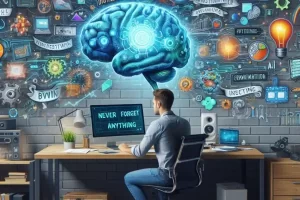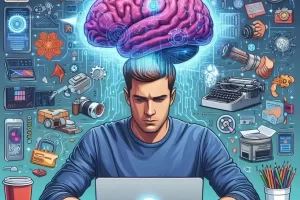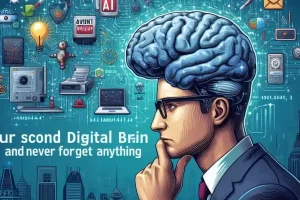Learning isn’t just about consuming information — it’s about processing, retaining, and applying what you’ve learned. In a world filled with online courses, podcasts, newsletters, and YouTube tutorials, it’s easy to feel like you’re always learning… but not really growing.
That’s where your second brain, enhanced by artificial intelligence (AI), comes in. Together, they help you build a learning system that captures insights, strengthens memory, and turns knowledge into action — without information overload.
In this article, you’ll learn how to use your second brain and AI to learn faster, remember more, and create a lifelong learning engine.
Why We Forget What We Learn
Most people:
- Highlight books but never review them
- Take courses without notes
- Watch educational content passively
- Forget 90% of information within a week
- Never apply what they consume
That’s because:
- Learning is unstructured
- Information is scattered across platforms
- There’s no system for review or reflection
- Notes are disorganized and hard to revisit
A second brain gives your learning a home and a process.
AI helps you structure, summarize, and surface what matters.
Define What You Want to Learn and Why
Start with intention. Ask yourself:
- What do I want to understand deeply this year?
- What skills or knowledge will move me forward?
- What areas do I want to explore just for curiosity?
Create a “Learning Goals” page in your second brain with:
- 📚 Topics of focus
- 🧠 Learning outcomes
- 🎯 Connection to your goals or values
- 🔁 Review schedule
Let AI support you:
“Based on my journal and projects, what learning areas should I focus on?”
“Create a 3-month learning roadmap around AI and content creation.”
“Suggest learning goals that align with personal growth and career development.”
Now your learning becomes deliberate and goal-driven.
Capture Learning in Your Own Words
Whether you’re reading, watching, or listening, always capture:
- ✍️ What stood out
- 💡 What you want to remember
- 🧩 How it connects to what you already know
- 🎯 How you might apply it
Create a standard learning note template with:
- Title and source
- Summary (in your own words)
- 3–5 key takeaways
- Actionable ideas
- Tags (topic, theme, skill)
AI can help:
“Summarize this podcast episode in 5 bullets.”
“Turn these highlights into a structured learning note.”
“Reword this technical concept so I can explain it simply.”
This turns passive intake into active learning.
Use Spaced Repetition to Retain More
Your brain needs review to remember. Use your second brain to:
- Schedule spaced review sessions (e.g., 1 day, 1 week, 1 month)
- Resurface forgotten notes regularly
- Quiz yourself or summarize from memory
Let AI automate review:
“Which notes should I review this week based on my spaced repetition plan?”
“Create a flashcard set from these 10 learning notes.”
“Generate a quick quiz from my last 3 reading entries.”
Now you’re learning to remember, not just to forget.
Connect Ideas Across Topics
The best learning happens when ideas connect.
Use backlinks, tags, and AI to:
- Link related ideas across different books or courses
- Spot patterns or repeated themes
- Build “hub notes” that summarize broad concepts like “decision-making,” “creativity,” or “AI tools”
Ask AI:
“What other notes relate to this new insight about deep work?”
“Group my learning notes by theme.”
“What patterns show up in my learning on psychology and business?”
This builds a knowledge network, not just isolated notes.
Apply Learning Through Projects and Teaching
Knowledge sticks when you use it.
Connect learning to:
- 🛠 Real projects
- 🧑🏫 Teaching others (blog posts, videos, presentations)
- 📋 Problem-solving
- 🎯 Personal growth experiments
Let AI help:
“Turn this learning note into a LinkedIn post.”
“Suggest how I could apply this principle to my business.”
“Write a script to teach this concept in simple terms.”
Now you’re not just learning — you’re creating from what you learn.
Review Your Learning Journey Monthly
Reflection locks in insight. At the end of each month, ask:
- What did I learn?
- What stood out or surprised me?
- What ideas changed how I think or act?
- What’s the next step in this topic?
Use AI for review:
“Summarize everything I learned about productivity this month.”
“What new concepts appeared in my reading log?”
“Suggest next learning steps based on this month’s notes.”
You’ll start to see your intellectual evolution clearly.
Build a Personal Knowledge Library That Grows With You
Over time, your second brain becomes your greatest teacher. Maintain:
- A searchable database of everything you’ve learned
- Evergreen notes that evolve and improve
- Tags and links for fast retrieval
- A sense of pride in your mental library
AI can assist:
“What are the top 10 most interconnected ideas in my second brain?”
“Which concepts have I returned to most often?”
“How can I simplify my learning system for even faster note-taking?”
Your second brain becomes a mirror of your mind — organized, intelligent, and always growing.
Real-Life Example: The Lifelong Learner
You’re someone who reads 2–3 books per month, follows expert podcasts, and loves learning.
Your second brain includes:
- A learning dashboard with current focus areas
- AI-assisted notes from every book, course, and podcast
- A spaced repetition schedule integrated into your weekly review
- A “Lessons Learned” library sorted by domain
- Monthly summaries of your biggest insights and favorite content
You don’t just learn — you build wisdom that compounds for life.
Final Thoughts: Learn Intentionally, Remember Powerfully
With a second brain and AI:
- You organize and retrieve ideas instantly
- You remember more with less effort
- You connect concepts across time and space
- You use knowledge to grow, teach, and create
- You become the architect of your own evolution
This is not about learning more.
It’s about learning better, deeper, and forever.




